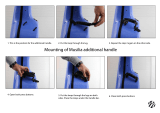
5
3.2 General safety instructions
Basics
Before using the carrier, please read through the Owner’s
Manual carefully. Failure to comply with the safety
instructions may result in serious personal injury or death, to
both the user and/or the occupants of the carrier.
When using the carrier, always comply with local safety and
accident prevention regulations, as well as the local Road
Traffi c Act, all of which may restrict use in some way.
Safe and appropriate use of the carrier is your responsibility.
Before using the carrier for the fi rst time, acquaint yourself
with its handling characteristics away from public roads and
without carrying children. An empty carrier will tip over more
easily when going over obstacles with one wheel only than
one carrying a load. A fully loaded carrier makes greater
demands on the deceleration devices.
Negotiate inclines and corners with the utmost caution and
reduce speed when doing so.
As regards the children carried
Never leave your child unsupervised in the carrier.
Regularly check that your children are appropriately clothed
and that they feel comfortable especially in hot and cold
temperatures.
Only children who can sit up without support may be carried,
unless the Chariot Infant Sling is used.
The maximum height of children who may be carried
is 111 cm.
In carriers designated as single-seaters only one child
may be carried; in two-seater carriers the maximum is two
children.
Make sure that the limbs, clothing or toys of the child do not
come into contact with the carrier wheels or the rear wheel of
the towing bicycle.
As regards the carrier
Never carry any heavy or sharp protruding items in the
storage space of the carrier if you are also carrying children
at the same time (risk of injury on braking).
Items of luggage should be well secured so that they cannot
move around during the journey. Unsecured items of luggage
and overloading reduce riding stability and make the carrier
more diffi cult to handle.
The carriers are bicycle carriers and must never be towed
behind motorised vehicles.
The carriers must not be carried on the roof of a vehicle,
even when folded, as they will get damaged.
At various points on the carrier, self-locking nuts are used. If
these have been loosened they must not be reused. Once
they have been loosened they lose their original function,
and this can lead to unexpected loosening of the screw
connection with potentially serious consequences.
Do not use the carrier at temperatures below -20°C /-4°F
and do not store it at these temperatures. The windows may
break.
When folding up or opening the carrier, there is a risk of
pinching your hand or fi ngers.
•
•
•
•
•
•
•
•
•
•
•
•
•
•
•
•
•
As regards the children in the carrier
When converting with other CTS Conversion Kits, no
child should be sitting in the carrier, nor when carrying out
maintenance or repair work.
The permitted total cargo load of the carrier is limited to
34 kg / 75 lb on the single-seater and 45 kg / 100 lb on the
two-seater. This must never be exceeded. The cargo load
is the weight of the children together with any luggage there
might be.
Please explain to your child that he/she must not bounce,
fi dget or lean out of the carrier.
3.3 Safety information for all travelling situations
As regards the children carried
Never carry items of luggage on the seat next to your child.
Never carry animals together with your children.
As regards the carrier
Take care when travelling over uneven surfaces. The carrier
can overturn if driven with one wheel only across uneven
ground, even at very low speed.
In the event of the carrier tipping over, the handlebar acts as
a safety bar. For this reason keep it permanently fi tted.
Before each journey check the tire pressure. The minimum
recommended pressure is 30 psi (2.1 bar) and the maximum
is 35 psi (2.5 bar). Even if a higher pressure is permitted
for the tires fi tted, the Manufacturer recommends that
35 psi (2.5 bar) not be exceeded. Air pressure that is too high
considerably reduces the comfort of the children, especially
on carriers without suspension. Air pressure that is too high
can also cause the plastic wheels on the Cheetah model to
fail.
Do not use compressed air lines (e.g. at service stations).
The tyres may burst due to the small volume of the tubes.
Never go up or down steps with the carrier.
Before each journey check that the wheels are fully engaged.
Before each journey check that the folding auto-lock disk is
fully engaged.
Before each journey check that the spring buttons of the
handlebar are fully engaged.
As regards the children in the carrier
Never carry your children without fastening all the seatbelts
in the proper manner, otherwise your child could be seriously
or even fatally injured in the event of an accident. Always
make sure the seatbelts are properly adjusted to the height
of your child.
When travelling faster than walking pace, always use at the
very least the mesh component of the two-in-one weather
cover.
As the children get in and out, the parking brake must be on
to prevent the carrier from accidentally rolling away.
•
•
•
•
•
•
•
•
•
•
•
•
•
•
•
•






















